3,000 Steps with a Medical Student
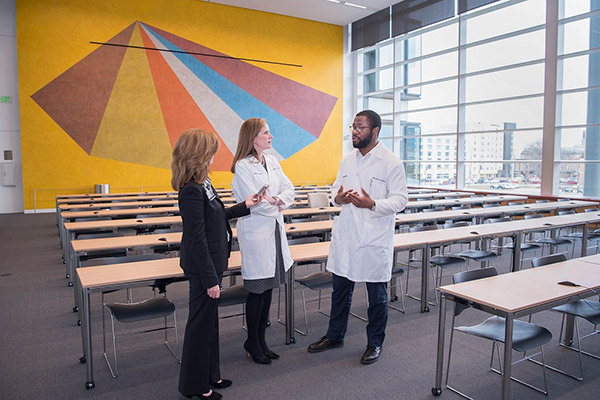
By Jill Stefancin
Christine Warren, MD, who serves as Associate Dean of Admissions and Student Affairs at Lerner College of Medicine, meets me in the soaring lobby of the Sheila and Eric Samson Pavilion. The four-story glass-and-steel structure is part of the Health Education Campus on Cleveland Clinic’s main campus, which opened to students in summer 2019. Second-year medical student Anthony Onuzuruike joins us. He’s tall and looks comfortable in his white medical coat.
Suddenly, students who are between classes spill into the atrium lobby carrying laptops and coffee cups, chattering with classmates as they find a place to sit, grab a bite from one of the cafés and plug in to recharge. Then, just as quickly, the students pack up and disappear down hallways that lead to the classrooms on the building’s perimeter. The three of us set off to explore the new building and discuss how it’s changed the learning experience.
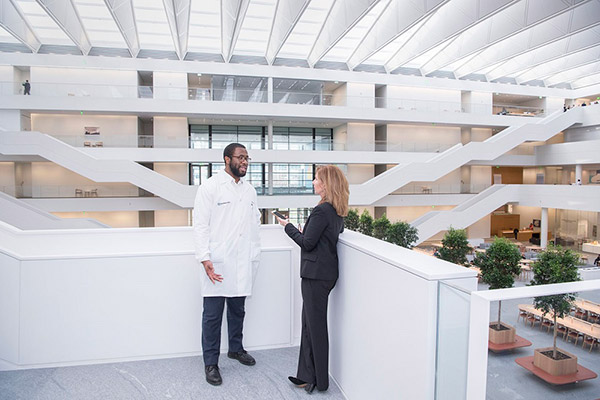
Lerner College of Medicine student Anthony Onuzuruike talks with the author in the atrium lobby of the Sheila and Eric Samson Pavilion.
‘New Opportunities in these Walls’
Dr. Warren, a dermatologist, is uniquely qualified for her admissions and student affairs role. “I was in the first graduating class in 2009 – we like to refer to ourselves as the Pioneers,” she says with an easy smile. “Hopefully, the students feel comforted by the fact that I've been through something like this before. This is their chance to shape new opportunities in these walls. In fact, a common reaction to the building from students is awe – they cannot believe that this building is actually a medical school and they get this as their space. Anthony is part of the class that is transitioning from our old location.”
“Having everything in one building has made it a lot more convenient,” Anthony says when asked about the former location of the medical school on the second floor of the Lerner Research Institute. “Before, it was difficult to identify who other med students were, but in this building it’s easier to keep up with them. I love the fact that I now have closer relationships with a lot of my counterparts.”
Dr. Warren agrees. “It’s important to understand the building truly has allowed collaboration between the various disciplines – and that’s important for any team, any successful team,” she stresses. “The ability for our students to be exposed to nursing students, dental students, physician assistants and social workers during their training helps everyone better understand what they’re learning and what their training has been. Then, once they’re in the outpatient or inpatient setting taking care of patients, they’ll be better equipped to function at their individual best and as a team, and give patients the highest level of satisfaction with their care.”
Tuition-free Learning, Thanks to Philanthropy
The Lerner College of Medicine was established as a partnership between Cleveland Clinic and Case Western Reserve University in 2002 with a $100 million gift from Al and Norma Lerner. Unusual among U.S. medical schools, the Lerner College provides full tuition scholarships for its 32 admitted students each year.
“We often talk about this funding and the students are very appreciative,” Dr. Warren says as we climb the stairs to the second floor.
Anthony also is the recipient of a KeyBank Minority Medical Student Scholarship. “KeyBank is supporting underrepresented minorities and helping with the education at Lerner,” he explains, noting that students are responsible for costs such as books and supplies, housing, food, personal expenses and transportation.
So You Want to be a Doctor?
After a brief tour of the classrooms on the second floor, Dr. Warren heads back to work and I continue walking with Anthony to find out why he wants to become a physician. We stroll along the second- and third-floor walkways overlooking the atrium. He speaks thoughtfully and has a quiet yet confident manner – just what you’d want in a doctor.
“Both my parents are in the medical field – my mom’s a nurse and my dad’s a chiropractor – and probably as early as I can remember my mom always told me I’d be a physician,” he begins. “In high school I had the typical love of sciences and they generally came pretty easy to me. I also love math so when I went to college my decision was to study chemistry and biology.”
Anthony grew up in Kansas City and received his undergraduate degree from the University of Missouri. After graduating, he ended up taking two gap years, joining a post-baccalaureate program at the National Institutes of Health in suburban Maryland.
“When I decided to go to medical school, my decision process was unique,” he says. “The first thing was to choose a community where I could make an impact outside of academics. I also decided that I wanted to work in more of an urban environment, which Cleveland obviously provided.”
In addition to the curriculum’s emphasis on research, Anthony was impressed with the school’s philanthropic and creative opportunities. “There’s an annual Peru Health Outreach Project or PHOP, which is a student-led medical trip that provides screening for underserved communities in Peru,” he says. “The Community Health Improvement initiative is another program where a group of medical students visits a local men’s homeless shelter every Friday to provide screenings and general health education. The place is phenomenal – they’ve got a ton of great people working to help these homeless men get back on their feet and start working again. Another reason why I chose Lerner was the medical humanities journal, Stethos, which features work from students here at Lerner.”
Going Where He’s Needed
Anthony is leaning toward the medicine track instead of the surgical track because he enjoys the conversations and relationships that are built with patients. “Not that you can’t do that in the surgical track, but I’ve had a lot of fun in our longitudinal clinics,” he says. “They’re unique to our program, giving students exposure with patients early on in first and second year. We take their history, do physical examinations and even get familiar with the electronic medical records used by Cleveland Clinic. So by the time we’re third year, we have a lot more experience working directly with patients. When you combine the basic science background and education you’re getting in those first two years with the clinical experience, it makes learning a lot easier.”
As to where he’ll end up after he graduates from medical school, Anthony’s keeping the door open. “Faith is a huge part of my life and I’ve decided to leave that ‘final destination’ thought process to wherever God takes me. So whether I'm in Cleveland, Kansas City, D.C., California or even Nigeria – where my family's from – wherever I'm needed, I think, is where I want to be.”
And with that, we say goodbye and Anthony heads off to class because that’s where he’s needed right now.
How You Can Help
Your Support Counts! Your gift to help fund medical education impacts the next generation of caregivers.
A New Florida Home for Transformative Research
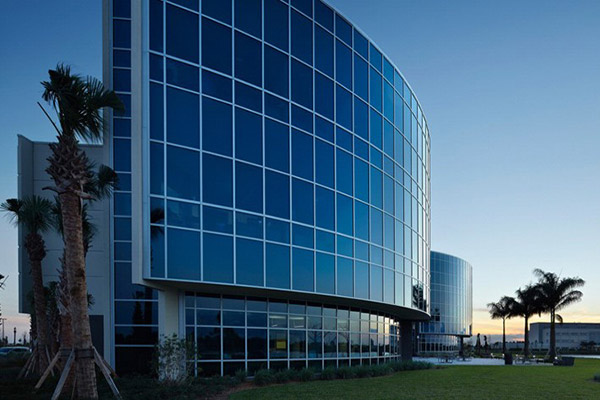
What if a new vaccine could prevent or treat a life-threatening disease in your family? What if every person fighting cancer had access to a new potentially life-saving clinical trial? What would the world be like with cures for today’s most devastating illnesses? Researchers at the Cleveland Clinic Florida Research and Innovation Center in Port St. Lucie, Florida, will seek answers to some of those very questions.
Established in November 2019, the new center is a significant step in Cleveland Clinic’s effort to create a translational vaccine and immunotherapy institute that will advance therapies in the areas of cancer and infectious disease.
“Our vision is to create a research institute dedicated to producing life-saving innovations,” says Joseph Iannotti, MD, PhD, Cleveland Clinic Florida’s Chief of Staff and Chief Academic and Innovation Officer. “A world-class research program needs leading-edge research facilities, which is what we now have in Florida.”
Following the signing of a 15-year lease with an option to buy, Cleveland Clinic took occupancy of the Florida Center for Bio-Sciences building, located across from Cleveland Clinic Tradition Hospital and next to the Torrey Pines Institute for Molecular Studies research facility in St. Lucie County. The building features 107,000 square feet of high-tech laboratory and office space situated on eight acres of land.
A Catalyst for Collaboration
The new Florida Research and Innovation Center is positioned to complement and expand clinical research underway at the health system’s five Florida hospitals. It also will enhance research conducted at Cleveland Clinic’s world-renowned Lerner Research Institute, which is home to 1,400 scientists and support staff on the main campus in Ohio. These scientific teams will work together, tapping into resources at both facilities to discover and translate new treatments for patients around the globe.
Initially the center will be home to at least 100 full-time researchers and support staff, and there is room to grow with the help of grant funding and philanthropic support. In addition to housing Cleveland Clinic Florida research teams, the center is partnering with Miami-based Florida International University for joint recruitment of research scientists and providing shared opportunities for graduate student training. Other partnerships will bring new technologies and innovation to the facility, underscoring Cleveland Clinic’s commitment to attracting the best and brightest medical minds to the region.
“Good science is a collaboration between multiple stakeholders and multiple groups,” Dr. Iannotti says.
“Our new Florida Research and Innovation Center will be a catalyst for collaboration, bringing together local and national research partners to solve some of the world’s most pressing healthcare problems.”
Cleveland Clinic also will pursue collaborations with leading basic science institutes that have opened Florida facilities in recent years and form joint education and research programs with institutions of higher learning to advance research, train tomorrow’s caregivers and improve healthcare delivery in Florida.
From Bench to Bedside
Basic science research addresses why and how diseases occur so that therapies can be developed, while clinical research is conducted to ensure new therapies and technologies are safe and effective. Translational research is a bridge between the two. The Florida Research and Innovation Center will conduct all three vital forms of research, which are needed to improve patient health outcomes.
“This research continuum allows scientists and investigators to take bench discoveries and create leading-edge diagnostics, preventatives and treatments,” Dr. Iannotti says.
Research at the new institute will focus on immunotherapies in oncology and infectious diseases. But the possibilities for future research are endless, Dr. Iannotti notes.
For nearly 100 years, Cleveland Clinic has contributed new discoveries and innovations that have changed the face of medicine on a global scale. With that institutional knowledge and experience, it is poised to achieve the same level of success in Florida.
“Discovery, development, and implementation of new treatments are expensive and take time,” says Cleveland Clinic Florida CEO and President Wael Barsoum, MD. “With the help of our donor community, we will create a world-renowned research institute here in Florida dedicated to advancing medicine and saving lives.”
How You Can Help
You can help Cleveland Clinic transform patient care for countless Floridians and people everywhere by making a gift to support the Florida Research and Innovation Center.
Your Gift in Action: Caregiver Catalyst Grant Fills Gap
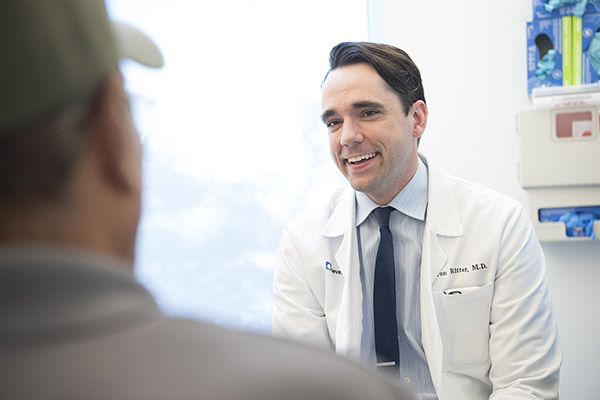
The funding just wasn’t quite enough.
Even so, Aaron Ritter, MD, Director of Clinical Trials at the Cleveland Clinic Lou Ruvo Center for Brain Health in Las Vegas, was incredibly grateful for the grant from the Centers of Biomedical Research Excellence (COBRE) that he received in 2015. He and his team pushed forward with their observational study of Alzheimer’s disease patients, Parkinson’s disease patients and a cognitively normal control group, a total of 150 participants in all.
Dr. Ritter’s project is the first to study Alzheimer’s and Parkinson’s patients simultaneously, with a goal of providing new insights into the genetics, neuroimaging and cognitive correlates of cognitive decline in these two neurodegenerative diseases.
Patient assessments in the study include neuropsychological testing, functional and structural magnetic resonance imaging (MRI), comprehensive genetic analysis and an amyloid positron emission tomography (PET). But the grant funding covered PET scans only for the Alzheimer’s patients and the control group.
Dr. Ritter hoped the research could build on smaller studies showing that as many as 35% of patients with Parkinson’s have the presence of amyloid plaques, which is the major pathology in Alzheimer’s. PET scans are useful because they reveal metabolic changes at the cellular level. This is important because diseases often begin with functional changes in the cells. A PET scan often can detect these very early changes, whereas MRI or computed tomography (CT) detects changes later, when the disease begins to affect the structure of organs or tissues.
When Dr. Ritter learned about Cleveland Clinic’s Caregiver Catalyst Grants, he immediately applied. In January 2019, he was awarded $76,500 to cover the cost of PET scans for 20 of the Parkinson’s patients in the study.
Caregiver Catalyst Grants
Launched in 2018, the Caregiver Catalyst Grants were created to help Cleveland Clinic employees, known as caregivers, implement their best and brightest ideas and positively impact patients and communities. Gifts to the Caregiver Catalyst Grants fund are combined to support these innovative projects. Twice a year, caregivers from all across Cleveland Clinic are invited to apply for a Caregiver Catalyst Grant, ranging from $10,000 to $100,000. Through a competitive process, these one-time grants are awarded to the projects that show the most promise for making an impact within one year.
“This grant is allowing the expansion of amyloid PET scans to 20 participants with Parkinson’s who have mild cognitive impairment (PD-MCI),” says Dr. Ritter. “PD-MCI is a well-established prodromal stage for dementia in Parkinson’s disease and may represent an important time period to apply interventions that may prevent further cognitive decline.”
Limited Research into Cognitive Decline
Although Parkinson’s is often conceptualized as a motor disease, its non-motor symptoms, including cognitive decline, gastrointestinal distress and psychosis, have been shown to place a greater burden on patients’ quality of life. Cognitive decline has been reported as the most bothersome symptom to patients and their families. There has been limited research into treatment for cognitive decline in Parkinson’s, despite the fact that it affects almost all patients at some point during their disease course.
Dr. Ritter notes that data from the project already has contributed to a number of articles, abstracts and original research projects. “This specific project, funded by a generous Caregiver Catalyst Grant, fills in an important gap in the COBRE, allowing us to further understand the effects of amyloid on people with Parkinson's disease,” Dr. Ritter says. “We’re able to continue our work in advancing PD research that ultimately will lead to significant improvements in therapies targeted at improving cognition in people with PD.”
How You Can Help
100% of your gift to the Caregiver Catalyst Grants will advance projects like Dr. Ritter’s that lay the groundwork for medical breakthroughs, expand patient support services and support community health and wellness programs.
Personal Best: Grateful for Care, Family Supports Research
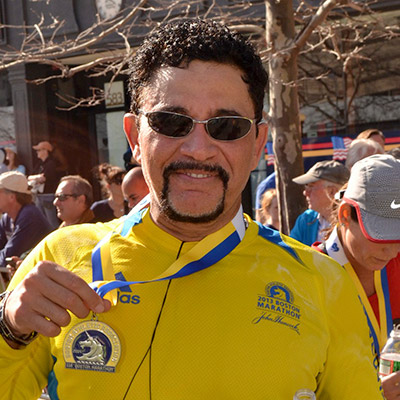
Columbus, Ohio-area dermatologist Julio Cruz, MD, had long dreamed of running the Boston Marathon. But his healthy habits slipped during the grueling years of his medical school and residency, and he gained weight. Encouraged by his mother in 2006, he began running to lose weight – eventually shedding more than 100 pounds.
“She would cook all the delicious amazing Latin dishes and I asked her if she really wanted me to lose weight,” Dr. Cruz recalls with a laugh. “But I went ahead and started running to try to lose the weight, not for competition or anything. Then I did a 5K, then a 10k, then a half marathon ... by 2013, I’d run more than 100 races.”
A Dream, Interrupted
He qualified for the Boston Marathon in 2013. But as he was nearing the finish line where his wife and daughter waited to congratulate him, the explosions began. In the chaos that followed, he never finished the race.
The bombings at the Boston Marathon left the family with emotional scars and particularly affected his daughter, whose trauma caused him sleepless nights, stress and worry – so much that he ended up hospitalized.
That’s when doctors discovered a problem with one of his heart valves that needed surgical repair.
However, Dr. Cruz was determined to finish what he’d started the year before: the Boston Marathon.
He decided to run the marathon in April 2014 before having heart surgery because his body was so conditioned to running long distances. “It was a bit controversial,” he admits. “But I tell you, there are some things in life you have to do, and this was one of those things.” He did use a mobile EKG monitor while he was running and finished the race without incident.
Showing Appreciation
Dr. Cruz had the surgery in November 2014 and remains grateful for the skill and the expertise of Cleveland Clinic’s Cardiovascular Medicine program that’s helped keep him healthy.
When his daughter was diagnosed with a neurological condition in 2018, the family immediately turned to Cleveland Clinic for her care.
To show his appreciation for the excellent medical care they received at Cleveland Clinic, Dr. Cruz and his family have made a $100,000 gift to support cardiovascular and neurological research.
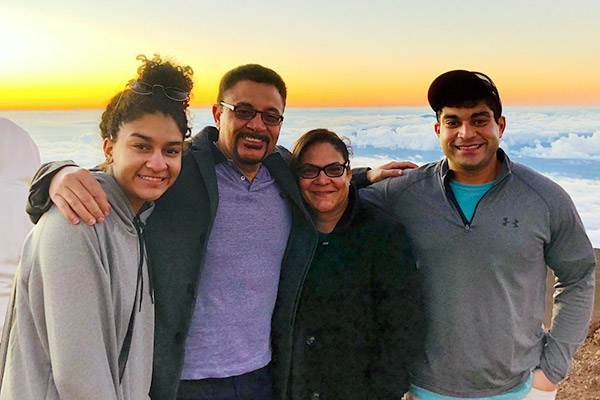
Julio Cruz, MD, with his wife and children.
After more than 25 years in Columbus, Dr. Cruz considers Ohio his home, thanks to his family, a successful dermatology practice, his time teaching at The Ohio State University and volunteering his medical skills at the area’s VA hospital. He credits his parents for their philanthropic influence on his life. “That’s what I learned, to be kind and compassionate and true to your faith,” he says. “My hope is that I pass this on to my children.”
How You Can Help
The Cruz family’s generosity is directly contributing to research that will impact the lives of patients and families. All gifts, no matter the size, help advance medical innovation, education and patient care at Cleveland Clinic.
Donor Shows Appreciation for Right Type of Surgery
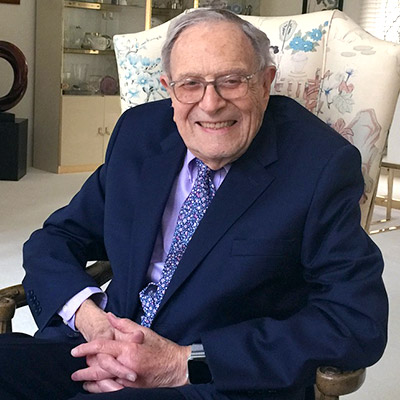
Bertram “Bert” Aaron is just as grateful to Cleveland Clinic for what didn’t happen as for what did happen when he needed aortic valve replacement surgery.
When his friend Linda Kaufman, a longtime supporter of Cleveland Clinic, learned of his heart trouble, she immediately put him in touch with cardiologist James Young, MD, Chief Academic Officer for Cleveland Clinic and former Executive Dean of the Lerner College of Medicine. Dr. Young holds the George and Linda Kaufman Endowed Chair, which Linda established in 2003 after her husband George passed away.
Dr. Young, who is not a surgeon, introduced him to Lars Svensson, MD, PhD, Chair of the Sydell and Arnold Miller Family Heart & Vascular Institute, who became Aaron’s heart surgeon.
Aaron was expecting to have a minimally invasive procedure, transcatheter aortic valve replacement (TAVR). However, Dr. Svensson advised otherwise.
“He was the only doctor with whom we consulted who realized that I was not a candidate for TAVR,” Aaron says. “He spoke frankly on a peer level with my daughter, Dr. Cynthia Aaron, who is a very fine emergency medicine physician.”
Planned Giving to Help Medical Students
To express his gratitude, Aaron was considering making a gift to Cleveland Clinic. After a conversation with Dr. Young, Aaron had an idea. “He showed me his plans for the new medical school,” Aaron says, referring to the Health Education Campus that opened to students in summer 2019. “I was thrilled and tried to think of some way, with my limited means, that I could be part of his dream.”
A planned gift was the answer. “Choosing an estate gift gave me the opportunity to use a system approach in allocating how I wanted my estate to be distributed. With rigorous estate planning, I was able to make a rational decision in administering it in the manner that I wished,” he says.
Aaron opted to establish a fund that will help medical students in critical situations. “In the past, students have lived under high stress because the demands of a medical education are great,” he says. “When a student enters an unexpected personal crisis, I hope that this fund will in some way help.
“Cleveland Clinic treated me with great care and respect,” Aaron says. “I have always believed that the future of our country, even our civilization, depends on excellent education of our youth, and that the future of medicine lies in excellent medical education and excellent medical research.”
He’s excited about being able to help make a difference. “Cleveland Clinic is superb. Dr. Svensson has given me many more years of happy, productive living. For this, I am very grateful. He saved my life.”
How You Can Help
Gift planning is a creative process that allows you to express your personal values by integrating your charitable, family and financial goals. A variety of options are available for you to plan today for tomorrow.

